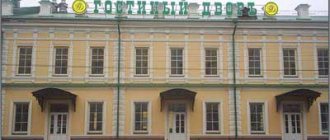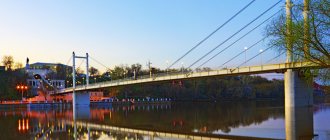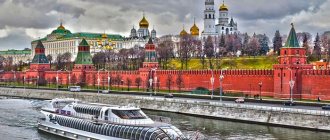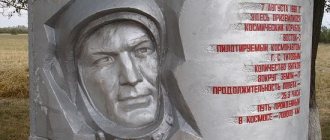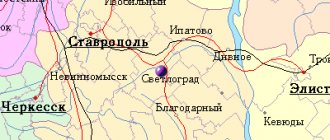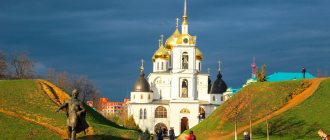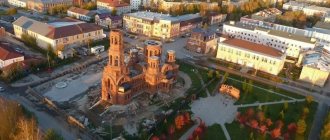- Reports and messages
- Miscellaneous
- Orenburg
The most wonderful and beautiful city in Russia is Orenburg.
The city became famous thanks to Lyudmila Zykina’s famous song “Orenburg Down Shawl” and the most significant event of Soviet times was the raising of the virgin lands of Orenburg. It so happened historically that the foundation of the fortress city was laid three times in different places at the confluence of the Ori and Yaika (Ural) rivers, but was postponed due to some reasons. This was due to flooding of both rivers, rocky terrain and a number of other reasons. At first, the city was a fortress, then a province, and by decree of Anna Ioannovna, the city of Orenburg, until the significant event of the 50th anniversary of the pilot Chkalov, in honor of which the city was renamed for almost 20 years.
Orenburg is divided into two districts, Northern and Southern, which in turn have two more districts. The population according to 2019 data is more than 560 thousand people. The majority are occupied by Russians, followed by Tatars and Kazakhs.
Significant people who glorified their city were:
- T.Shevchenko
- M. Jalil
- N. Karamzin
- I. Krylov
- M. Rastropovich and many others.
The city is an industrial center of the Ural region and a scientific and educational center, where a number of research and educational institutes of various profiles operate.
Yuri Gagarin received his flight education here.
Orenburg is considered a green city and is surrounded by numerous parks and squares. The beautiful historical and modern streets of the city are full of neon high-rise buildings and one-story houses, museums and monuments. Sovetskaya Street is called the local Arbat; it is exclusively pedestrian.
The sights of the city are:
- Local history museums and estates
- Caravanserai
- St. Nicholas Cathedral,
- Gostiny Dvor
The peculiarity of the city’s location is that Europe and Asia connect here.
Foundation of the city
This settlement was not formed spontaneously, like most settlements in Russia. The idea to build a city came to the mind of the Kazakh Khan. He promised Queen Anastasia to protect the integrity of the lands, protect the borders from attacks and help merchants if in return they built a fortress that would serve as a shelter in case of danger.
This is where the history of the city of Orenburg begins. On August 31, 1735, the first stone was laid for the construction of a large and reliable fortress. This building is located at the confluence of the Or and Yaik rivers.
A funny situation happened with the choice of place. The first expedition led by I. Kirillov identified the ideal location. However, after his death, V. Tatishchev moved the construction site downstream of the Yaik. And again a miss, as the terrain turned out to be rocky and far from the river.
And only in 1739 the final version was determined and approved - the former Berd fortress. The history of Orenburg began, and the city was nicknamed thrice conceived and once born.
FIRST SUBURBS
Forstadt. In the mid-50s of the 18th century, on the eastern side of the fortress, immediately behind the moat, the first settlement appeared - a Cossack settlement, called after the Church of St. George, or Yegoryevskaya, as well as Kalmyk, since the majority of its population were baptized Kalmyks registered as Cossacks. The settlement lasted only about twenty years. When there was a threat of a siege of Orenburg by the army of E.I. Pugachev, the settlement was burned out. This has been done with the outskirts since time immemorial, since the buildings could be used by the besiegers as shelters.
The secondary emergence of the settlement is associated with severe fires in the spring of 1786, after which the authorities decided to evict the extra people outside the city and locate the buildings in the fortress at a greater distance from each other. This time, the suburb (forstadt, as it began to be called) was built separately from the city, at a distance, because an esplanade was supposed to be left around the fortress, that is, a free space 130 fathoms wide (more than 277 meters). Only Cossacks settled in the suburbs.
Forshtadt began from modern Vystavochnaya Street and Krasny Lane. Later, the western border ran approximately along Red Square, the northern - first along Malo-Leninskaya, then gradually moved to the line where 12th December Street is located. By the beginning of the 20th century, the suburb reached Turkestan - its limit on the northern side. For a long time its eastern border did not go beyond the line of Stepan Razin Street, the southern border ran along the natural border - the slope to the Ural floodplain. By 1915, the blocks ended at Parkovskaya and Khleborobnaya streets.
At first, the suburb was considered as a city suburb, but gradually became isolated and became a village with its own administration. On the plans of Orenburg, the suburb was not always shown or street names were not given. Therefore, it was basically possible to establish only those that were given after the redevelopment that began in 1879 in connection with the fire.
Origin of the name
The origin of the name of the place becomes clear to anyone who has delved even a little into the geography of Russia, especially the Orenburg region. Everyone immediately associates it with the Or River and the part “burg”, which in German means “city”. Literally, the name, based on this concept, is translated as “hail on Ori”. There is an opinion that I. Kirillov gave this name to the newly built settlement. He also sent a package of relevant nomination documents to Empress Anastasia.
Also, the history of Orenburg does not allow us to discard the version that the name came from the Kazakh “orybor”.
It is worth noting that due to misunderstandings with the location of the fortress, this name was long borne by the first fortress founded by Kirillov. However, over time, the empress issued a decree in which the right to be called Orenburg was assigned only to the place that still bears this name.
Since 1938, the city was renamed Chkalov, in honor of the famous pilot. By the way, the latter had nothing to do with this area. In 1957, the settlement again received its historical name.
First decades of life
The history of Orenburg, or rather, the territory of the modern city and region, changed dramatically after the construction of the fortress. Residents of other Russian regions began to occupy the region of nomads. And next to this fortification, dozens of defensive structures were erected, ditches were dug and high walls were built.
Initially, soldiers were moved here in the hope that they would start farming. But the history of the city of Orenburg indicates the opposite - the warriors, unencumbered by relatives, did not demand much, therefore they had no desire to get rich and get hold of a household.
Then it was decided to create Cossack irregular troops, where even fugitives were accepted. Peasants began to develop the virgin steppe lands.
However, there were not so many artisans. The city grew and strengthened thanks to trade and over time became a powerful center, which along with the surrounding lands turned into the Orenburg province.
World War I
In July 1917, the Alash party was formed, which discussed issues of governance and power. Representatives were delegated from it to the All-Russian Constituent Assembly. Thus, the history of Orenburg acquired its own political force.
These years have become a difficult test for the city. Cossack formations repeatedly suffered defeats from the Red Army. At that time, many regiments began to call themselves White Cossacks and did not accept changes. In addition, the national heterogeneity of the population made itself felt.
The history of Orenburg cannot briefly mention these events. A lot of blood was shed in those days. Just look at the capture of the City Council, when all the people there were slaughtered, even women and old people.
Soviet Union times
Everything changed with the advent of Soviet power. The population has grown sharply, almost sixfold. Since there were no violent battles in this region due to its remoteness, it was decided to evacuate large industrial facilities here, many of which remained here.
Throughout the Union, Orenburg became famous for its down scarves, getting which as a gift was the highest sign of care.
During World War II, airplanes and helicopters were produced in the city. Then other industries appeared. For Orenburg, this meant the emergence of new jobs, so over time, residents of other regions began to move here.
The history of the streets of Orenburg tells about all the changes that took place in the city.
Modern period
After the collapse of the USSR, the city lost its popularity for a while. This continued until the end of the twentieth century. However, in the 2000s, a course was set to increase the prestige of Orenburg, and the economy was rebuilt.
The city has become more attractive to tourists thanks to development programs. Old buildings began to be actively restored. Events were held online to familiarize users with the city and its history.
The Orenburg History Museum also played an important role in this matter. It contains exhibits telling about the life of the city. A number of traditional events are held there every year, and field trips are also organized.
Prices for visiting are more than reasonable, and the convenient location is another plus that guests of the city will appreciate.
Every street and house speaks about the city. One way or another, they remind us of what happened here in different periods. To immediately capture the maximum amount of information about the area, residents, and attractions, just visit the Orenburg History Museum.
PIGEON SLOBODKA
Somewhat later than the suburb, around 1812–1814, another suburb appeared to the west of the fortress - Golubina Slobodka, which began as a small settlement of exiles. It was located at the intersection of modern Chernorechenskaya and Pionerskaya streets, and in 1797 it was about 80 meters long. Golubinaya, or Soldatskaya Slobodka, was located between modern Chicherin Street and the slope to the Ural floodplain. Mostly retired soldiers, artisans and people of “other status” were settled here, but not Cossacks. In 1819, the poorest strata of the city were evicted from the city to the settlement, and it grew significantly, but back in the late 20s of the 19th century it almost did not go down, and from the east it was limited by a line along Chicherina and Postnikova streets to Kommunarov passage, walked along it and returned to Chicherina street.
In 1828, there were 3 government-owned and 374 philistine buildings. Gradually the settlement began to spread down on both sides of Chernorechenskaya Street.
Most of the streets and alleys received their names from the names of settlers who stood out in some way. The settlement was built chaotically; it came closest to the fortress near the Urals along the line of Yaitskaya Street. In the middle of the 19th century, its boundaries were limited below by modern Zavodsky Lane and Aktyubinskaya and Cherepanov streets.
To the north of the fortress, at the end of the 30s of the 19th century, a New Slobodka appeared and therefore Golubina at the same time began to be called Old. Fires often broke out here, a particularly severe one occurred in 1864. After him, a special commission was formed, which carried out some redevelopment. To reduce fire hazards, they planned to cut several lanes, but not all of them were completed. Fire victims were allocated 320 places in Novaya Slobodka.
Ghosts at the Medical Academy
Like any other settlement, Orenburg has its own legends and horror stories. One of the most popular is the ghost stories that infest the building of the Medical Academy. None of the residents can explain why the spirits are so dissatisfied that they cannot leave the monastery alone, however, this legend has been living for more than a century. There are even documented memories of one of the teachers. He says that once he was sent to calm the girls who were beside themselves with fear. The cadets told them about the ghosts, wanting to scare the students. However, the young people left, and the strange sounds did not stop, which forced the girls to make a fuss.
Many students say that even today restless spirits roam the building and can often be seen in the corridors or rooms.
Popular message topics
- History of the Computer
Computers are considered the greatest invention, and today there is probably not a single person who does not use a computer. At first, large computers were created, they were extremely inconvenient and difficult to use, and that’s all - Aluminum
Aluminum or another less common name, Clay, is a chemical. element, in the periodic table. Mendeleev is located at atomic number 13, a chemical element of the 3rd group. Aluminum is a light metal - Underwater world
If you look at the world map, you can see that there is a lot of blue on it. These are rivers, seas, oceans. And more than half of the animals, plants and fish live in them. The nature of the underwater world is very amazing.
The mystery of the first metro
There once lived in Orenburg a certain Gorodissky, who worked as a lawyer. His desire for the female sex pushed him to many extravagances - either he decorated the house with stucco to entertain the ladies, or he was ready to defend the honor of the lady, even if the forces were not equal.
But the most talked about legend is that he allegedly built a subway under his house for fun. These were two rails and a cart that reached the next street.
In any case, the city will not leave anyone indifferent.
NEW PLAN
In the spring of 1879, there were several devastating fires in the city. They accelerated the planning of the new area, which received the name New Plan, later called New Construction. By this time, the population growth rate had increased significantly, which was associated with the development of industry and the introduction of the Samara railway.
The new blocks were planned on a rectangular grid, since the radial streets of Novaya Slobodka spread out quite widely, and they had to be doubled again in order for the block length to comply with fire regulations. For the same reasons, new development began from modern Orskaya Street, leaving the area between Novaya Slobodka and the New Plan. The name “New Plan” reflected the essence of the layout. The terrain was laid out between the Berdinskaya and Novo-Kargalinskaya roads. The external border ran along the lines of modern Orskaya, Astrakhanskaya, Grebenskaya and Tereshkova streets. In the middle, a square was left, called Nikolaevskaya; in our time, part of it is occupied by a garden named after the October Revolution. In the 90s of the 19th century, the area on the other side of modern Tereshkova Street was divided.
A further significant increase in the New Plan occurred in 1906, when the blocks were laid out to modern Shevchenko, Poltavskaya streets and Kanareykina passage. The official development of pre-revolutionary Orenburg was completed here. Between Novaya Slobodka and Novostroika, on the one hand, and the suburb, on the other, there were carriage and blacksmith rows, a hay market, windmills, hay cards, a convent, and to the east of it, in the area of modern Kharkovskaya Street, there were gunpowder warehouses.


